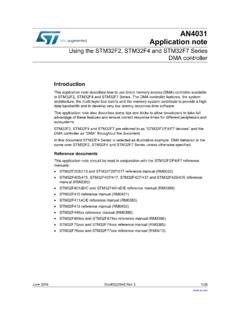Transcription of stm32
1 stm32 # stm32 Table of ContentsAbout1 Chapter 1: Getting started with stm322 Remarks2 What is stm32 ?2 Product series2 Development boards2 Versions3 Examples3 First time setup with blink LED example using SW4 stm32 and HAL library3 IDE installation3 Creating a project3 Blink LED application6 Chapter 2: Integrated development environments (IDEs)10 Introduction10 Remarks10 Examples13SW4 stm32 : System Workbench for STM3213 Introduction13 Installation14 IAR-EWARM14 Introduction14 Installation15 Atollic - TrueSTUDIO15 Introduction15 Installation15 CoIDE15 Introduction15 Installation16 Chapter 3: UART - Universal Asynchronous Receiver/Transmitter (serial communication)17 Introduction17 Examples17 Echo application - HAL library17 Transmit large amount of data using DMA and interrupts - HAL library18 Credits22 AboutYou can share this PDF with anyone you feel could benefit from it, downloaded the latest version from: stm32It is an unofficial and free stm32 ebook created for educational purposes.
2 All the content is extracted from Stack Overflow Documentation, which is written by many hardworking individuals at Stack Overflow. It is neither affiliated with Stack Overflow nor official content is released under Creative Commons BY-SA, and the list of contributors to each chapter are provided in the credits section at the end of this book. Images may be copyright of their respective owners unless otherwise specified. All trademarks and registered trademarks are the property of their respective company the content presented in this book at your own risk; it is not guaranteed to be correct nor accurate, please send your feedback and corrections to 1: Getting started with stm32 RemarksThis section provides an overview of what stm32 is, and why a developer might want to use should also mention any large subjects within stm32 , and link out to the related topics.
3 Since the Documentation for stm32 is new, you may need to create initial versions of those related is stm32 ? stm32 is a 32-bit Flash microcontroller family developed by ST Microelectronics. It is based on the ARM Cortex M processor and offers a 32 bit product range that combines very high performance, real-time capabilities, digital signal processing, and low power, low voltage detailed description about each series , development tools and part number decoding can be found on seriesCortex-M0 / -M0+Cortex-M3 Cortex-M4 Cortex-M7 High performance: stm32f2 stm32f4 stm32f7 , STM32H7 Mainstream:STM32F0 STM32F1 STM32F3 Ultra-low-power:STM32L0 STM32L1 STM32L4 Development boardsSTM32 Nucleo (mbed enabled)Discovery kitsEvaluation boardsTypical use case:Flexible prototyping, communityPrototyping, creative demosFull feature evaluationExtension possibilities:+++++++Connectivity.
4 Arduino , ST, time setup with blink LED example using SW4 stm32 and HAL library(Note: There are many IDE, toolchain and library which are ready-to-use with stm32 . The following setup requires minimal effort to get it work, but it is only one of the many. Feel free to explore others, it is not the purpose of this example to force anyone to use the tools that will be used here.)IDE installationSystem Workbench for stm32 : free IDE on Windows, Linux and OS X. It has been built by AC6 and available for download after registration from the OpenSTM32 Community's IDE itself is based on Eclipse, but comes with some extras for stm32 development like:Ac6 stm32 MCU GCC toolchain OpenOCD and GDB (arm-none-eabi-gdb) with automatically generated debug configurations depending on the target board Built-in options to program or erase chip To start with stm32 before creating your own board, it is recommended to experiment with a Discovery, a Nucleo or an Eval board, which come with an on-board SWD (Serial Wire Debug) programmer/debugger called a projectThis example will use an stm32f4 Discovery kit, which features an STM32F407VG microcontroller.
5 (Any other board can be used as well.)Open SW4 stm32 and create a new C project: File New C Project1. Give it a name like "STM32F4_Discovery-Blinky" and from the Project Type list choose the Executable/Ac6 stm32 MCU Project. By default the only available toolchain is Ac6 stm32 MCU GCC. Click step is Debug/Release settings, can be skipped now by clicking Board selection. Existing boards can be selected as in this example the stm32f4 Discovery or new custom boards can be step is Project Firmware configuration. Choose between No firmware, Standard Peripheral Library (SPL) or Hardware Abstraction Layer (HAL). It is questioned which one is more suitable for development, but this question is out of scope in this example.
6 This example will use the HAL library as it is the currently supported by ST Microelectronics. Additional available software tool for HAL is stm32 CubeMX, which is an initialization code generator. Also several example applications are available by the stm32 CubeFx or stm32 CubeLx software packages. Download the target firmware if it's missing and it is recommended select the "Add low level drivers in the project" and the "As sources in the application" options. Finally, click LED applicationAs this project has been created with an stm32f4 Discovery, there are already several ready-to-use functions under the /STM32F4_Discovery-Blinky/Utilities/STM3 2F4-Discovery/ project folder which can be used to interface the Discovery kit's peripherals (accelerometer, audio, LEDs, push button).
7 In this example the void BSP_LED_Init(Led_TypeDef Led) and the void BSP_LED_Toggle(Led_TypeDef Led) functions will be used from the file to blink the green LED, which is LED4. To decide which LED is which use the schematics of the Discovery actual pin and port names are already hidden by some #define and enum, use Ctrl + Click to track the main, call the HAL_Init() function which resets all peripherals, initializes the Flash interface and the Systick. (Systick will be used to generate delay for the blinking.)1. The system clock have to be configured. It can be done by using the stm32 CubeMX clock configuration feature or by the reference manual. In this example the system clock is fed by the internal PLL (Phase Locked Loop), which is sourced by an external 8 MHz crystal oscillator (HSE).
8 Prescalers have been set to achieve the maximum available frequency, which is 168 MHz in case of the F4 Initialization of the peripherals, in this case a GPIO Inside an endless loop, call the LED toggling and the HAL_Delay() function. HAL_Delay() uses the Systick and generates a delay in The whole code is the following:#include " " #include " " void SystemClock_Config(void); int main(void) { /* Reset of all peripherals, Initializes the Flash interface and the Systick. */ HAL_Init(); /* Configure the system clock */ SystemClock_Config(); /* Initialize one of the LED GPIO pin */ BSP_LED_Init(LED4); while(1) { BSP_LED_Toggle(LED4); HAL_Delay(1000).}}
9 // in miliseconds } } /** * @brief System Clock Configuration * The system Clock is configured as follow : * System Clock source = PLL (HSE) * SYSCLK(Hz) = 168000000 * HCLK(Hz) = 168000000 * AHB Prescaler = 1 * APB1 Prescaler = 4 * APB2 Prescaler = 2 * HSE Frequency(Hz) = HSE_VALUE * PLL_M = (HSE_VALUE/1000000u) * PLL_N = 336 * PLL_P = 2 * PLL_Q = 7 * VDD(V)
10 = * Main regulator output voltage = Scale1 mode * Flash Latency(WS) = 5 * @param None * @retval None */ void SystemClock_Config(void) { RCC_ClkInitTypeDef RCC_ClkInitStruct; RCC_OscInitTypeDef RCC_OscInitStruct; // Enable Power Control clock __PWR_CLK_ENABLE(); // The voltage scaling allows optimizing the power consumption when the // device is clocked below the maximum system frequency, to update the // voltage scaling value regarding system frequency refer to product // datasheet. __HAL_PWR_VOLTAGESCALING_CONFIG(PWR_REGU LATOR_VOLTAGE_SCALE1); // Enable HSE Oscillator and activate PLL with HSE as source = RCC_OSCILLATORTYPE_HSE; = RCC_HSE_ON; = RCC_PLL_ON; = RCC_PLLSOURCE_HSE; // This assumes the HSE_VALUE is a multiple of 1 MHz.}











